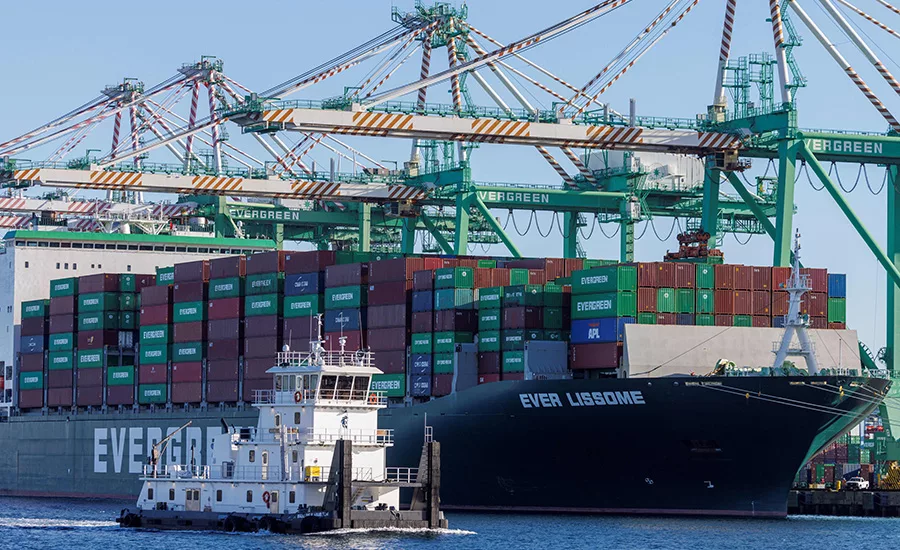News Analysis
Roofing Feels Port Pinch Despite Tariff Truce
As temporary U.S.-China tariff truce offers limited relief, drop in U.S. port traffic may be harbinger; new ABC report offers glimmer of good news

Roofing contractors brace for higher costs and delayed projects as U.S. port traffic plunges and tariff uncertainty disrupts material supply chains despite a pause in American-Chinese reciprocal tariffs.
— Image courtesy of Reddit and CNBC
Updated at 9:30 a.m. on 05/15
U.S. ports are reporting sharp drops in container traffic that threaten to ripple through the construction sector, pressuring project timelines and driving up costs for roofing contractors — even as a new 90-day trade truce between the U.S. and China offers a temporary supply-chain reprieve.
At the Port of Los Angeles, inbound cargo from Asia has plunged by roughly one-third compared to last year and could fall by 35% in May, Executive Director Gene Seroka said in an interview with CNBC. Experts say container volumes at both the Los Angeles and Long Beach ports will drop by a combined 30% year-over-year this month, according to Reuters — its worst performance since early 2020.
Together, the two California ports handle around 40% of U.S. imports from Asia. A slowdown of this magnitude is a bellwether for broader economic activity and a direct hit to industries reliant on imported construction materials.
“Less volume of cargo containers means less work for us,” longshore worker Charlie Camacho told NPR. “So we feel it, we definitely feel it.”
The slowdown comes just days after U.S. and Chinese officials announced a 90-day suspension of most reciprocal tariffs. The deal temporarily reduces U.S. duties on Chinese imports from 145% to 30%, and cuts Beijing’s tariffs on U.S. goods from 125% to 10%.
RELATED | Trade War Fallout: Contractors Are Delaying Projects and Cutting Crews
The move was intended to ease pressure on trade flows, but supply-chain experts caution that the impact may be limited.
Seroka noted the truce is unlikely to significantly boost imports in the short term, with many companies already pausing or canceling orders and dozens of ocean carriers announcing “blank sailings” — deliberate trip cancellations due to weak demand.
Analysts at Descartes Systems Group warn that weak consumer spending, ongoing policy uncertainty, and the impending expiration of key tariff exemptions could prolong the downturn into the third quarter.
Adding to the pressure, U.S. tariffs under Section 232 remain in force, including a 25% duty on imported steel and aluminum and 20–25% tariffs on Canadian softwood lumber and select specialty building products. These materials are essential for roofing systems, from galvanized flashings and fasteners to sheathing and underlayment.
The National Retail Federation and Hackett Associates now project U.S. containerized imports to fall 20% year-over-year in the second half of 2025 if large retailers continue holding back on new orders from China. Drewry Maritime Research expects global container port volume to decline by 1% this year, largely due to U.S. trade policies.
Even on the East and Gulf coasts, where some ports have recently posted record volumes, officials remain cautious. The Port of Savannah reported a 22.5% increase in March container traffic, while Port Houston saw a 7% bump — but both signaled concern about future slowdowns and market volatility.
Effects Felt on Construction Sites
The Associated General Contractors of America reported a 0.4% increase in nonresidential construction input prices in March — the third consecutive monthly rise.
Ken Simonson, AGC’s chief economist, warned that “rapid-fire changes in tariffs threaten to drive prices higher for many essential construction goods,” a concern felt acutely by roofing firms dependent on steady material flows.
RELATED | ARMA Data Shows Mixed Q1 2025 for Asphalt Roofing Products

The Bureau of Labor Statistics’ April Producer Price Index, released on Thursday, indicated a continued rise in construction material costs; construction materials increased by 0.84% from the previous month.
In the roofing sector, the PPI for asphalt paving and roofing materials manufacturing stood at 386.72 in February; prepared asphalt and tar roofing products, including saturated felts for nonbuilding use, were 356.070. The modest 0.03% increase from the previous month hardly offsets a 4.40% rise compared to the same period a year earlier.
For commercial (nonresidential) construction, Associated Builders and Contractors’ weekly PPI “Data Digest,” covering April 7–11, highlighted outsized one-month jumps in key inputs, including steel mill products increasing 7.1%, aluminum mill shapes rising 5.1%, and lumber and plywood increasing 2.7%.
Roofing contractors and residential builders are also grappling with price hikes. According to the April NAHB/Wells Fargo Housing Market Index, 60% of single-family homebuilders said their suppliers had increased material prices due to tariffs, with an average month-over-month increase of 6.3%.
U.S. consumer inflation ticked up in April, with the Consumer Price Index for All Urban Consumers (CPI-U) rising 0.2% after a 0.1% decline in March, marking a year-over-year gain of 2.3%, the smallest 12-month increase since February 2021.
Core CPI, which excludes volatile food and energy, climbed 0.2% for the month and 2.8% over the past year.
The Bureau of Labor Statistics noted shelter costs — a major input for construction demand — rose 0.3% on the month and 4% compared with April 2024. Energy prices also edged higher, up 0.7%, driven by natural gas and electricity gains.
RELATED | New Poll Finds Roofers Losing Economic Confidence
Reprieve in the Data
ABC reported Tuesday that its Construction Backlog Indicator rose to a 20-month high of 8.7 months in April, according to an ABC member survey conducted April 22 to May 6. The reading is up 0.3 months since April 2024.
Contractors have a record volume of booked work, and profits are up. Still, rising material costs, tariff delays and mixed confidence in future sales and hiring suggest the sector may face a more uneven 2025.
Contractors with annual revenues exceeding $100 million have seen a significant increase in backlog over the past year. Although smaller contractors have experienced a modest rise in backlog, those with revenues between $30 million and $100 million have seen a decline compared to last year.
ABC’s Construction Confidence Index showed improved profit margins in April, but sales and staffing levels declined. However, the sales outlook is better than last year. All three components remain above 50, indicating anticipated growth over the next six months.
“Nearly 22% of contractors had a project delayed or canceled in April due to tariffs, up from 18% in March, while 87% have been notified of tariff-related materials prices increases,” said ABC Chief Economist Anirban Basu.
“[D]espite these headwinds [contractors remain busy]; backlog rose in April and is now at the highest level since September 2023,” Basu added. “While ABC members remain upbeat about the near-term outlook, the share of respondents that expect their sales to decline over the next six months rose to 19% in April, up 6 percentage points since the start of the year.”
QUICK READ: 5 Takeaways
- Port Traffic Plunges, Disrupting Supply Chains: Container volumes at major West Coast ports are down roughly 30% year-over-year, threatening material availability for construction and roofing projects.
- Tariff Truce Offers Limited Relief: A 90-day U.S.-China tariff suspension lowers duties but may not reverse declining imports, as many companies have already canceled or paused orders.
- Material Prices Continue to Climb: Construction input prices are climbing again. In March alone, steel mill products rose 7.1%, aluminum 5.1%, and lumber and plywood 2.7%, with April industry data pointing to further increases.
- Backlogs Grow Despite Uncertainty: ABC’s Construction Backlog Indicator hit a 20-month high in April, but confidence in future sales and staffing is weakening, especially among mid-sized firms.
- Contractors Urged to Adapt: With tariff-related delays affecting nearly 1 in 4 contractors, experts advise using staggered procurement, diversifying sourcing, and adding price-escalation clauses.
Contractors are advised to adopt more flexible procurement strategies. Supply chain consultants recommend staggered ordering to avoid glut cycles, sourcing from lower-tariff countries such as Vietnam or South Korea, and adding price escalation clauses to contracts to hedge against further volatility.
For roofing professionals and suppliers, the path forward remains uncertain. The tariff truce may offer some breathing room, but with shipping lines curbing capacity and demand still fragile, the risk of renewed bottlenecks — and higher costs — remains very real.
Looking for a reprint of this article?
From high-res PDFs to custom plaques, order your copy today!









